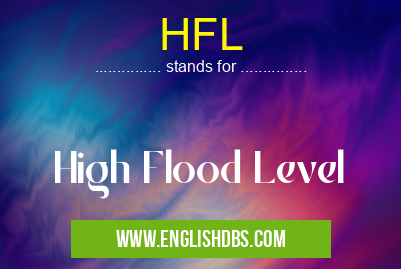What does HFL mean in GEOLOGY
HFL stands for High Flood Level, which refers to the stage of a river or other body of water during flooding. A high flood level can cause significant damage to a riverbank or shoreline, and is an important factor to consider when building homes in flood-prone areas. This article will provide an overview of HFL and answer some common questions about it.

HFL meaning in Geology in Academic & Science
HFL mostly used in an acronym Geology in Category Academic & Science that means High Flood Level
Shorthand: HFL,
Full Form: High Flood Level
For more information of "High Flood Level", see the section below.
Essential Questions and Answers on High Flood Level in "SCIENCE»GEOLOGY"
What causes a high flood level?
High flood levels are caused by heavy rainfall, melting snow, and runoff from land near the affected body of water. All these things cause the water levels to rise above their normal ranges and result in flooding conditions.
How can I prepare for a high flood level?
People living in areas prone to flooding should take steps to prevent damage from occurring. This includes creating barriers such as sandbags or building walls around parts of the property that are vulnerable when water levels rise, as well as making sure any electrical and plumbing systems are elevated above expected flood levels.
How can I tell if I am living in a high-flood-risk area?
Consulting local authorities is the best way to determine if you are living in an area at risk for flooding due to its proximity to rivers or other bodies of water. These authorities should have maps indicating which areas are likely at risk - check with your regional planning department or environmental protection agency office for more information.
What effects can high flood levels have on a property?
The impacts depend largely on how deep the flooding is and how long it lasts. Generally speaking, flooding can cause significant damage to buildings and their contents, as well as negatively impacting soil fertility due to soil erosion caused by moving waters. Damage may also include damage to roads and bridges encountered when attempting to access the flooded area.
Is it possible for HFLs to vary between years?
Yes - depending on weather conditions such as rainfall amounts or snowfall accumulation, HFLs may be higher or lower than they were during previous years. It's important to keep this in mind when preparing for potential floods each year, as this could affect your plans for protecting against damages from occurring.
Final Words:
High Flood Levels pose risks not only for people who live close by but also those further away since having extremely high levels creates dangerous weather events that might not exist otherwise like mudslides from eroding grounds near rivers etc; Understanding what causes them and being prepared before they happen is essential helping mitigate any damages that may occur due to their harsh impact.
